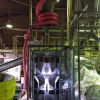Plastics separator
Technology description
| The name of the technology: | Plastics separator |
|---|---|
| Challenge: | Recycling and reprocessing of plastics is an increasingly resonant issue in society. The quality of reprocessed plastics depends on the purity of the input material, the separation efficiency, and the recycling process sustainability. Our technology, which is based on the principle of freefall electrostatic separation, respects current trends in sustainability and environmental friendliness, and is in line with the principles of the circular economy. Its additional value is the variability of the technical parameters, which allows for recycling various mixtures of different plastic types and separation of a specific plastic type from a heterogeneous mixture. |
| Description: |
Electrostatic separation is based on the principle of different charges of separated materials that the materials attain due to the triboelectric effect and the subsequent passage through a strong electric field. This way, it is possible to separate any mixtures sufficiently spaced materials in the triboelectric sequence. The separation itself begins with precise dosing (with a mass flow rate of up to 0.5 T/h) of dry (max. 50% humidity) shredded plastic with dimensions of 1-8 mm. The air conveyor, which also serves to charge the shredded plastic, feeds the material to a cyclone, from where the shredded plastic travels through a streaming device to a sorting chamber. Material separation occurs between two high-voltage electrodes. The material then travels through streaming collectors into collection vessels in which the separated material is stored. Our technology has been successfully tested in pilot plants for mixtures of various plastic (ABS, PE, PS, PVC, PP, etc.). For the ABS/LDPE mixture, the separation efficiency was 67% with a purity of 97%; for the ABS/PVC mixture, the efficiency was 66% and the purity 95%. The whole process is energy efficient; the power input of the high-voltage part of the separator is in units of watts. The device includes software enabling computer simulation and optimization of separator settings and their control. The software enables monitoring and controlling the separator during the separation process and significantly simplifies the operation of the device. |
| Commercial opportunity: | Separation of shredded plastic for recycling or reprocessing; purifying of contaminated plastic mixtures. |
| IP protection status: |
know-how, software |
| Development status: |
Phase 3Corresponds with TRL 5 and TRL 6 Technology validation and implementing it in real environment. Testing the technology outside of the laboratory and its adjustment to external conditions.
|
| Partnering strategy: | Collaboration investment licensing |
| More information: | https://www.youtube.com/watch?v=VpcQ87L54MI |
| Images: | |
| Categories: | Mechanical Engineering Electrical Engineering |
| Owner of a technology: | University of West Bohemia |

